Submitted:
02 March 2023
Posted:
06 March 2023
You are already at the latest version
Abstract
Keywords:
1. Introduction
2. Materials and Methods
2.1. Research Framework and Process
2.2. Selecting Representative Samples
2.3. Extraction and Factor Analysis of Modeling Imagery Adjectives
2.4. Modeling Imagery Opinions in Fuzzy Theory
3. Results and Discussion
3.1. Results of Representative Sample Selection
3.2. Results of the Modeling Imagery Adjectives Extraction and Factor Analysis
3.3. Results of Fuzzy Manipulation
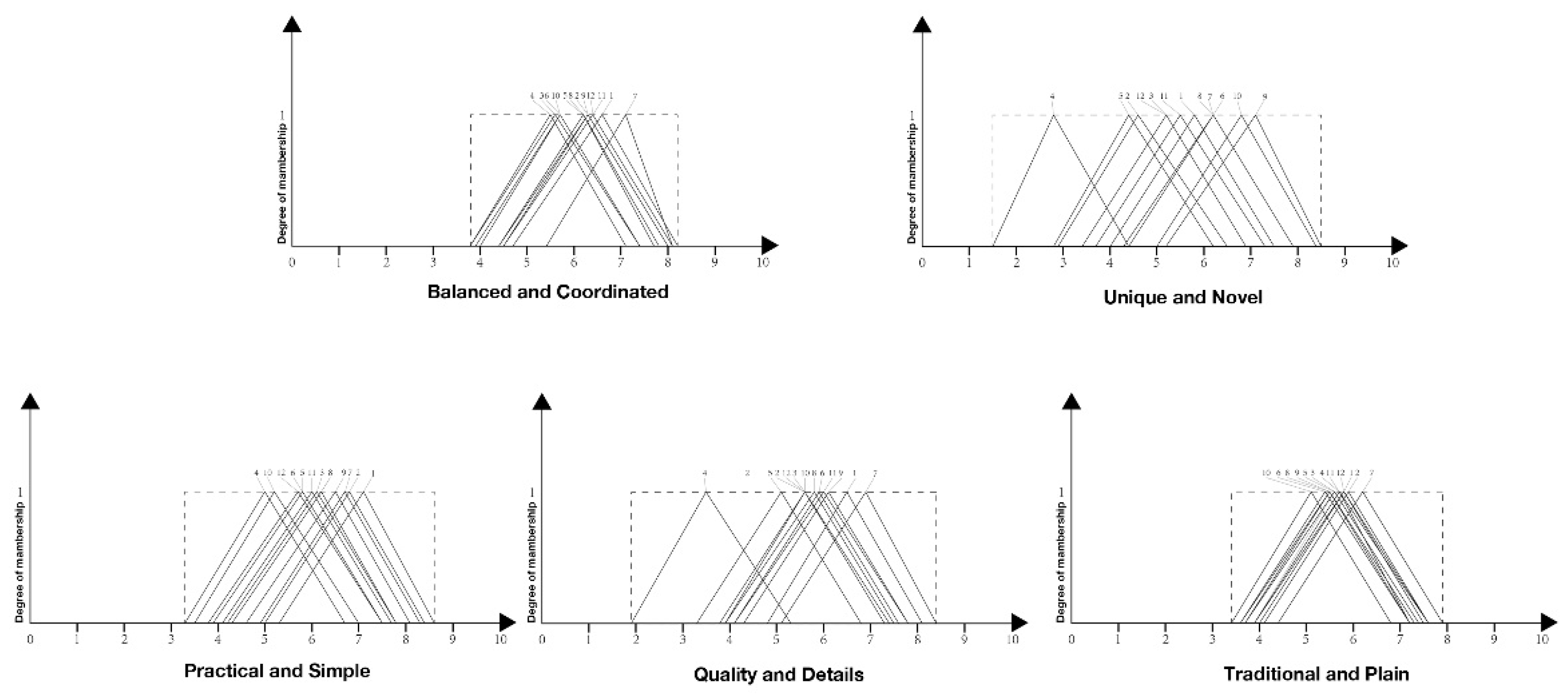
3.4. Experimental Validation
4. Conclusion
Author Contributions
Funding
Institutional Review Board Statement
Informed Consent Statement
Data Availability Statement
Acknowledgments
Conflicts of Interest
References
- Nagel, Christian, and Jan H. Schumann. Post-adoption buffering effects of innovative product aesthetics. Creativity and Innovation Management 2020, 29, 128–139. [CrossRef]
- Statista. INDUSTRIES&MARKET Furniture Report 2022. Available online: https://www.statista.com/outlook/cmo/furniture/worldwide (accessed on January 2022).
- Fortune Business Insights. FURNITURE MARKRT. Available online: https://www.fortunebusinessinsights.com/furniture-market-106357 (accessed on February 2022).
- Grand View Research. Furniture Market Size, Share & Trends Analysis Report. 2030. (GVR-2-68038-647-9). Available online: https://www.grandviewresearch.com/industry-analysis/furniture-market.
- Xu, Xiaoping, Shanyong Wang, and Yugang Yu. Consumer’s intention to purchase green furniture: Do health consciousness and environmental awareness matter? Science of the Total Environment 2020, 704, 135275. [CrossRef] [PubMed]
- Prospective Industry Research Institute. Panorama of China's Furniture Industry 2022. Available online: https://www.qianzhan.com/analyst/detail/220/220130-224b6779.html (accessed on 1 February 2022).
- Chen, Jianxiong, and Chung-Cheng Yang. The impact of the COVID-19 pandemic on consumers’ preferences for wood furniture: An accounting perspective. Forests 2021, 12, 1637. [CrossRef]
- Dell’Era, Claudio, Stefano Magistretti, and Roberto Verganti. Exploring collaborative practices between SMEs and designers in the Italian furniture industry. Researching open innovation in SMEs. 2018, 307–345.
- Peng Liang. Chair Design Research (first). (Chinese). Furniture & Interior Design Journal 2015, 10, 17–19.
- Charlotte & Peter Fiell. 1000 Chairs. TASCHEN, Berlin, 2017; pp. 6–8.
- Helander, Martin G. Forget about ergonomics in chair design? Focus on aesthetics and comfort! Ergonomics 2003, 46, 1306–1319. [CrossRef] [PubMed]
- Seva, Rosemary R., Henry Been-Lirn Duh, and Martin G. Helander. The marketing implications of affective product design. Applied Ergonomics 2007, 38, 723–731. [CrossRef] [PubMed]
- Yang, Chih-Chieh. A classification-based Kansei engineering system for modeling consumers’ affective responses and analyzing product form features. Expert Systems with Applications 2011, 38, 11382–11393. [CrossRef]
- Seva, R.R.; Duh, H.B.L.; Helander, M.G. The marketing implications of affective product design. Appl. Ergon. 2007, 38, 723–731. [Google Scholar] [CrossRef]
- X. Li, Z. Xiao and K. Yang. The Design of Seat for Sitting Posture Correction Based on Ergonomics. In Proceedings of the 2020 International Conference on Computer Engineering and Application (ICCEA), Guangzhou, China, 18–20 March 2020.
- Faudzi, A. A. M., Suzumori, K., & Wakimoto, S. Development of Pneumatic Actuated Seating System to aid chair design. In Proceedings of the 2010 IEEE/ASME International Conference on Advanced Intelligent Mechatronics, Montreal, QC, Canada, 6–9 July 201).
- Gustafsson, Stig-Inge. Furniture design by use of the finite element method. Holz als Roh-und Werkstoff 1995, 53, 257–260. [CrossRef]
- Haraga, Georgeta, and Adrian Mihai Goanță. FEA analysis and design optimization for a multifunctional piece of furniture. MATEC Web of Conferences. Vol. 112. EDP Sciences 03 July 2017.
- Barros, Mário, José Pinto Duarte, and B. M. Chaparro. Thonet chair design grammar: a step towards the mass customization of furniture. In Proceedings of the 14th international conference on computer aided architectural design futures, Liege, Belgium, 4–8 July 2011.
- Dosovitskiy, Alexey, Jost Tobias Springenberg, and Thomas Brox. Learning to generate chairs with convolutional neural networks. In Proceedings of the IEEE conference on computer vision and pattern recognition, Boston, USA, 07–12 June 2015.
- Z. Liu, F. Gao and Y. Wang. A Generative Adversarial Network for AI-Aided Chair Design. In Proceedings of the 2019 IEEE Conference on Multimedia Information Processing and Retrieval (MIPR), San Jose, CA, USA, 28–30 March 2019.
- Nagamachi, M. Nagamachi, M., Y. Okazaki, and M. Ishikawa. Kansei engineering and application of the rough sets model. Proceedings of the Institution of Mechanical Engineers, Part I:. Journal of Systems and Control Engineering 2006, 220, 763–768. [Google Scholar]
- Rohde, Douglas LT. Methods for binary multidimensional scaling. Neural Computation 2002, 14, 1195–1232. [CrossRef] [PubMed]
- Hébert, Pierre-Alexandre, Marie-Hélène Masson, and Thierry Denoeux. Fuzzy multidimensional scaling. Computational statistics & data analysis 2006, 51, 335–359.
- Borg, I.; Groenen, P.J.; Mair, P. Applied Multidimensional Scaling; Springer Science & Business Media: Berlin/Heidelberg, Germany, 2012. [Google Scholar]
- Kruskal, J.B. Multidimensional scaling by optimizing goodness of fit to a nonmetric hypothesis. Psychometrika 1964, 29, 1–27. [Google Scholar] [CrossRef]
- Kline, P. An Easy Guide to Factor Analysis; Routledge: London, UK, 2014. [Google Scholar]
- Huang, J. Multivariate Analysis, 7th ed.; Chinese Institute of Economics and Business: Taipei, Taiwan, 2000. (In Chinese) [Google Scholar]
- Brown, F.G. Principles of Educational and Psychological Testing, 3rd ed.; Holt, Rinehart and Winston: New York, NY, USA, 1983. [Google Scholar]
- Kline, P. An Easy Guide to Factor Analysis, 1st ed.; Routledge: London, UK, 1994. [Google Scholar]
- Kaiser, Henry F. The application of electronic computers to factor analysis. Educational and psychological measurement 1960, 20, 141–151. [CrossRef]
- Zadeh, Lotfi A. Fuzzy sets. Information and control 1965, 8, 338–353. [CrossRef]
- Zadeh, L.A. Outline of a new approach to the analysis of complex systems and decision processes. IEEE Trans. Syst. Man Cybern 1973, SMC-3, 28–44. [Google Scholar] [CrossRef]
- Zadeh, L.A. The concept of a linguistic variable and its application to approximate reasoning—I. Inf. Sci. 1975, 8, 199–249. [Google Scholar] [CrossRef]
- Park, J.; Han, S.H. A fuzzy rule-based approach to modeling affective user satisfaction towards office chair design. Int. J. Ind. Ergon. 2004, 34, 31–47. [Google Scholar] [CrossRef]
- Hsiao, S.W. Fuzzy logic based decision model for product design. Int. J. Ind. Ergon. 1998, 21, 103–116. [Google Scholar] [CrossRef]
- Lin, P.H.; Jin, Y.M. Applying fuzzy theory in selecting the image quality factors of 3D televisions. Int. J. Ind. Ergon. 2019, 74, 102841. [Google Scholar] [CrossRef]
- Dubois, D.; Prade, H. Operations on fuzzy numbers. Int. J. Syst. Sci. 1978, 9, 613–626. [Google Scholar] [CrossRef]
- Hsieh, C.H.; Chen, S.H. A model and algorithm of fuzzy product positioning. Inf. Sci. 1999, 121, 61–82. [Google Scholar] [CrossRef]
- Chen, S.H. Ranking fuzzy numbers with maximizing set and minimizing set. Fuzzy Sets Syst. 1985, 17, 113–129. [Google Scholar] [CrossRef]

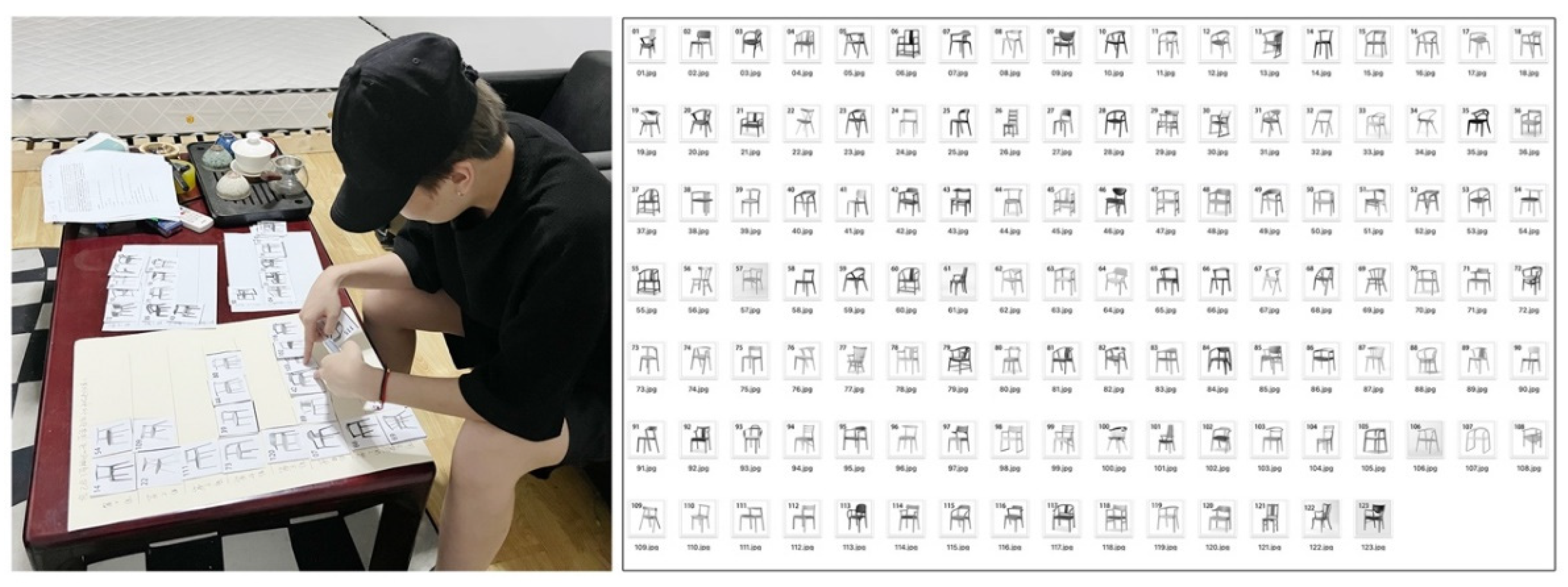
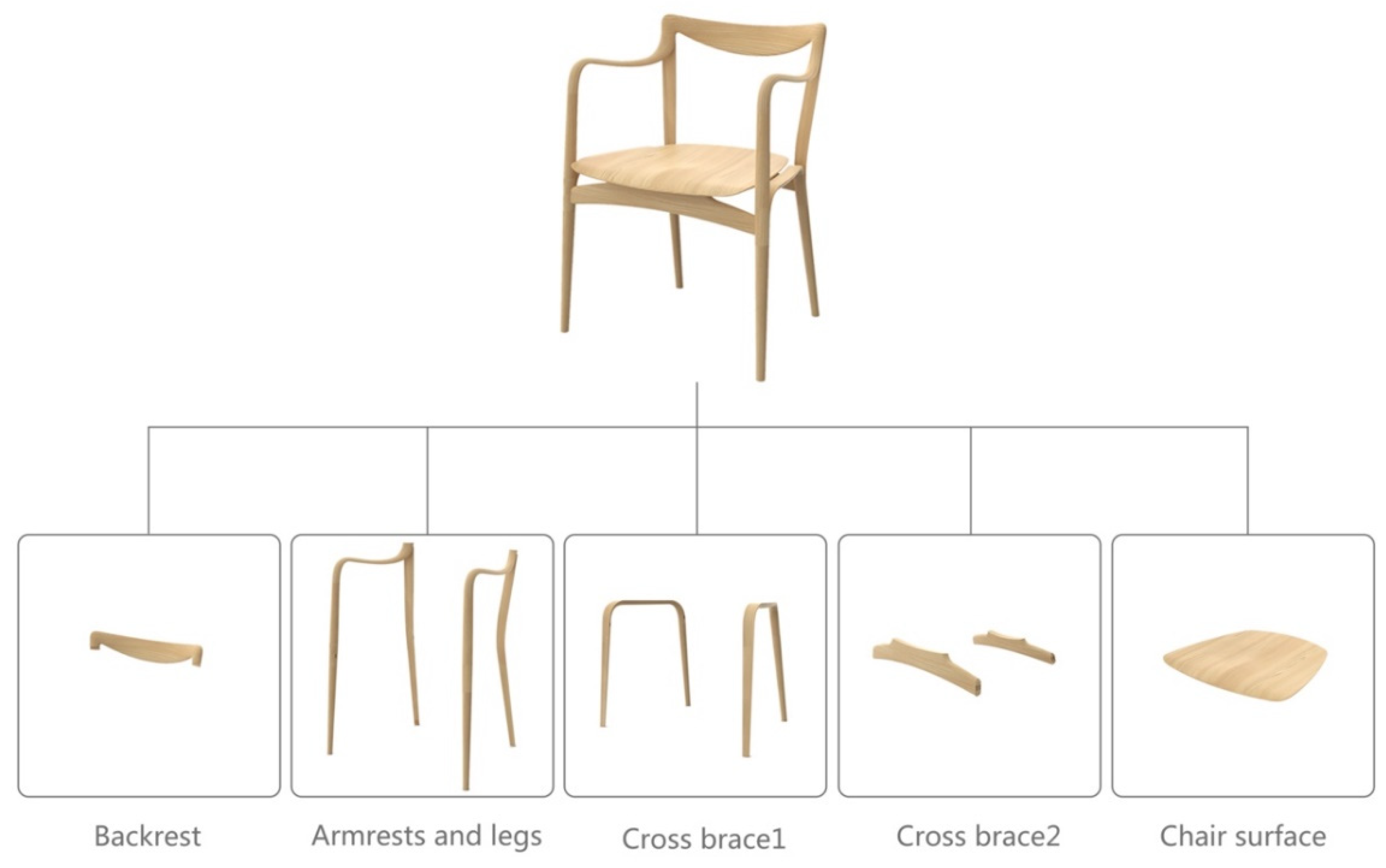
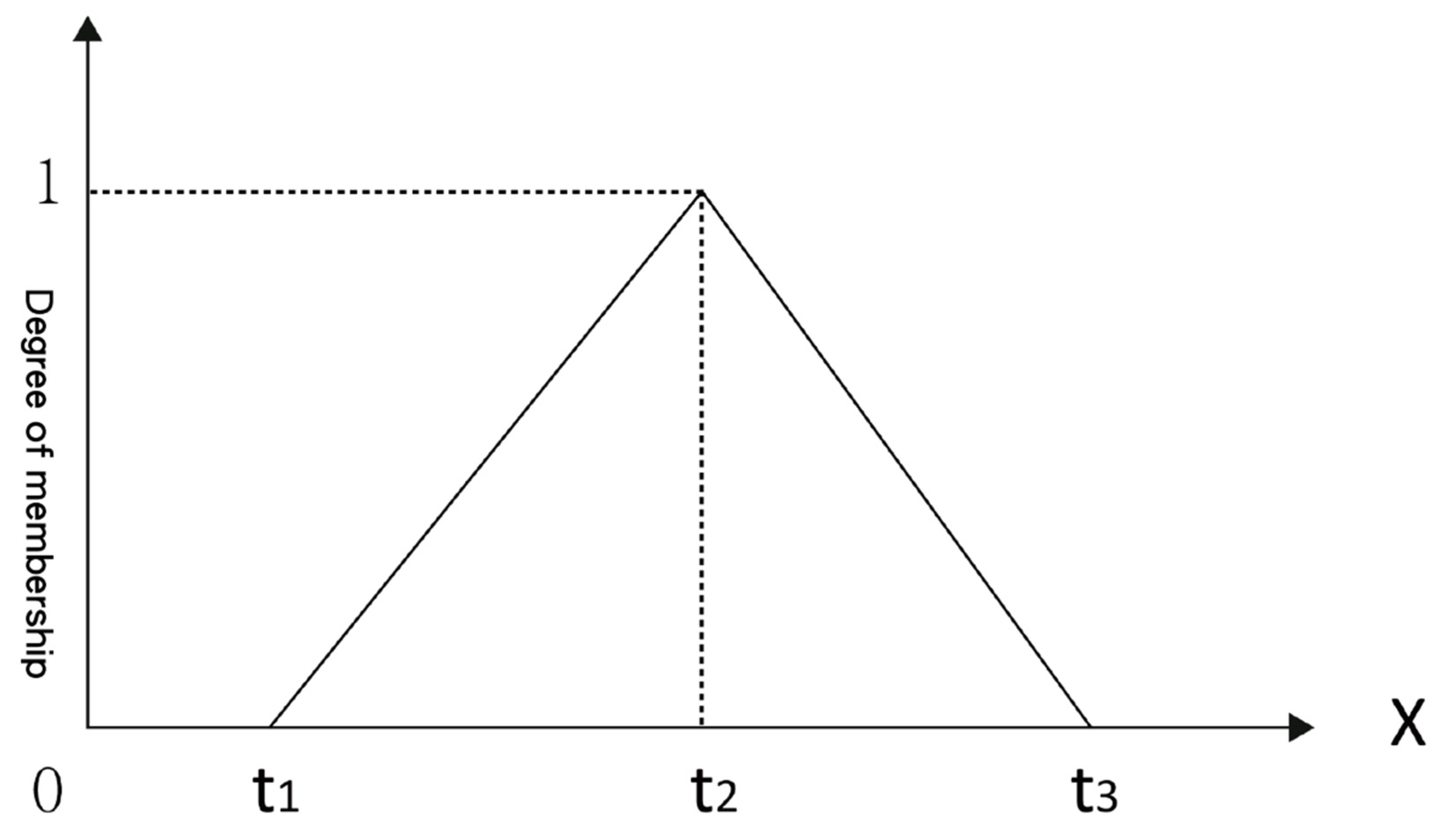
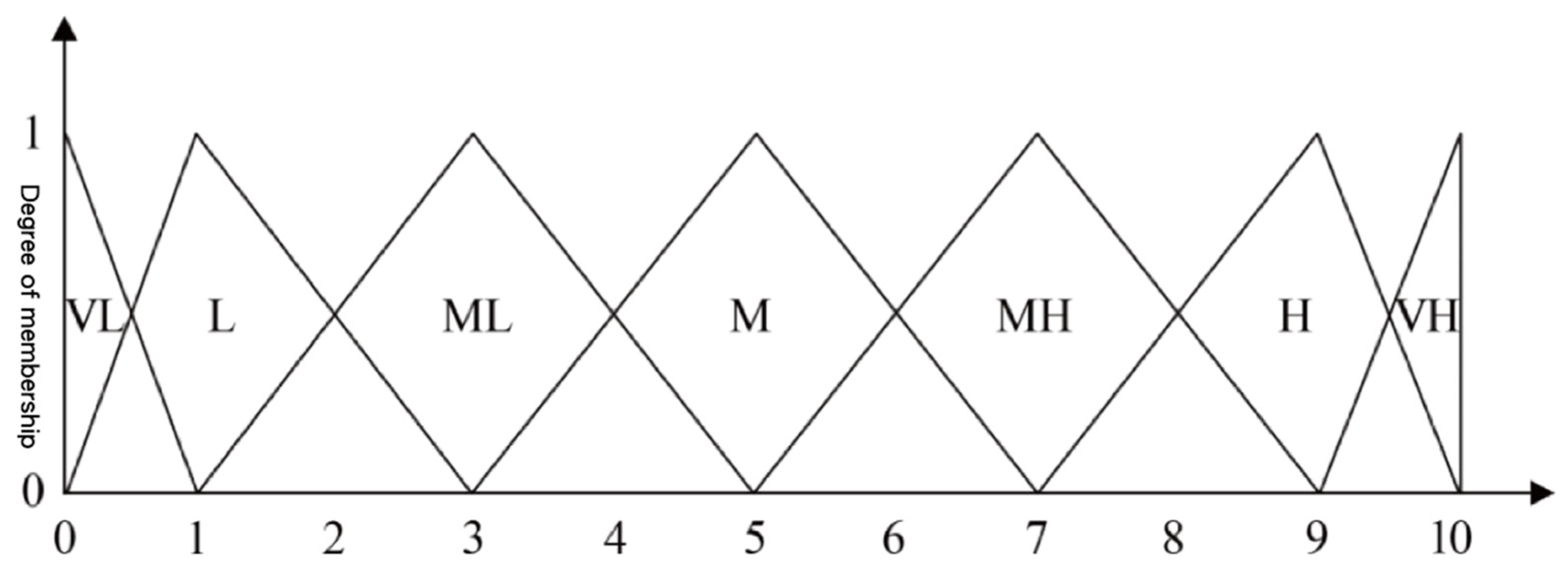
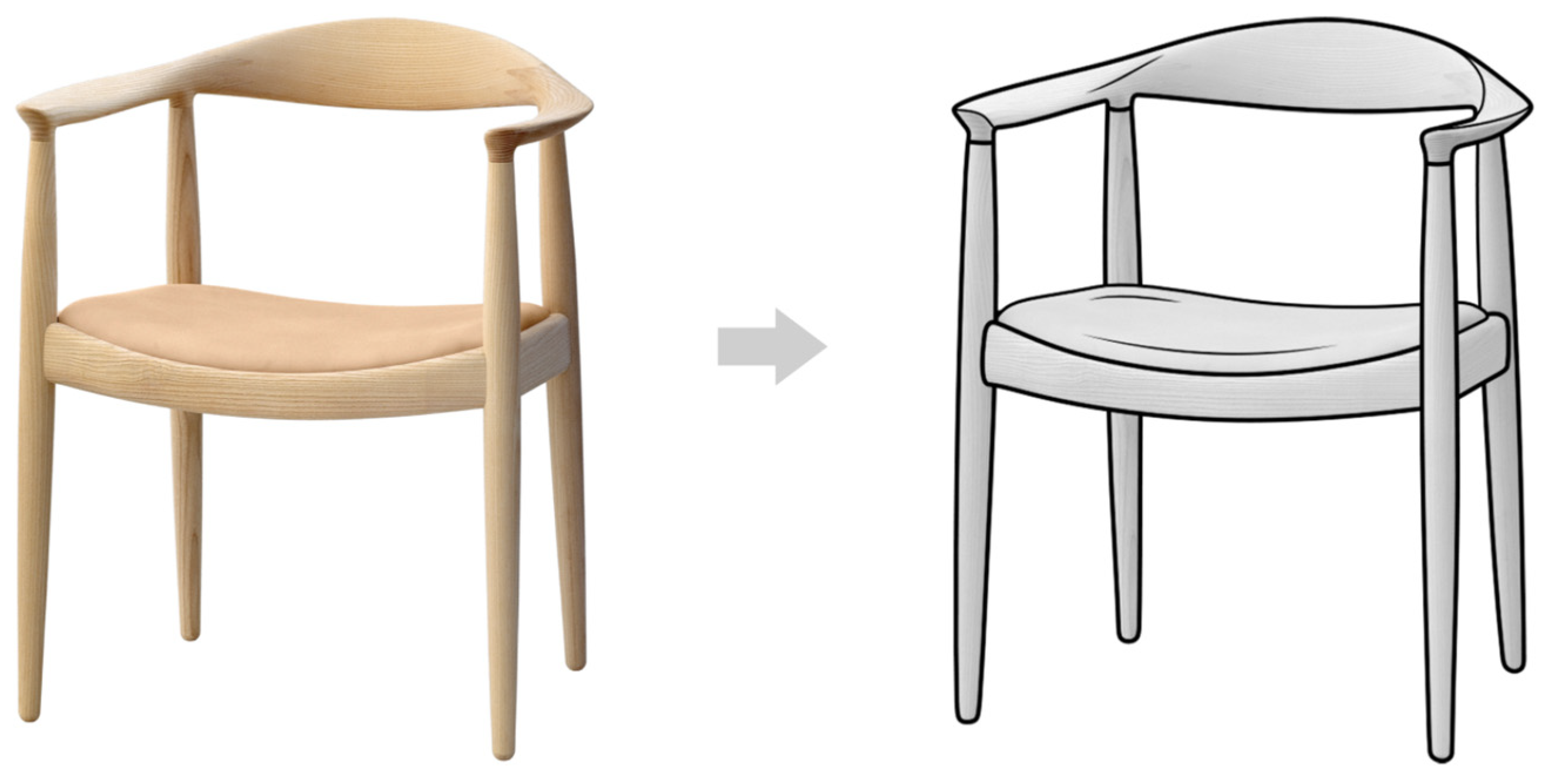
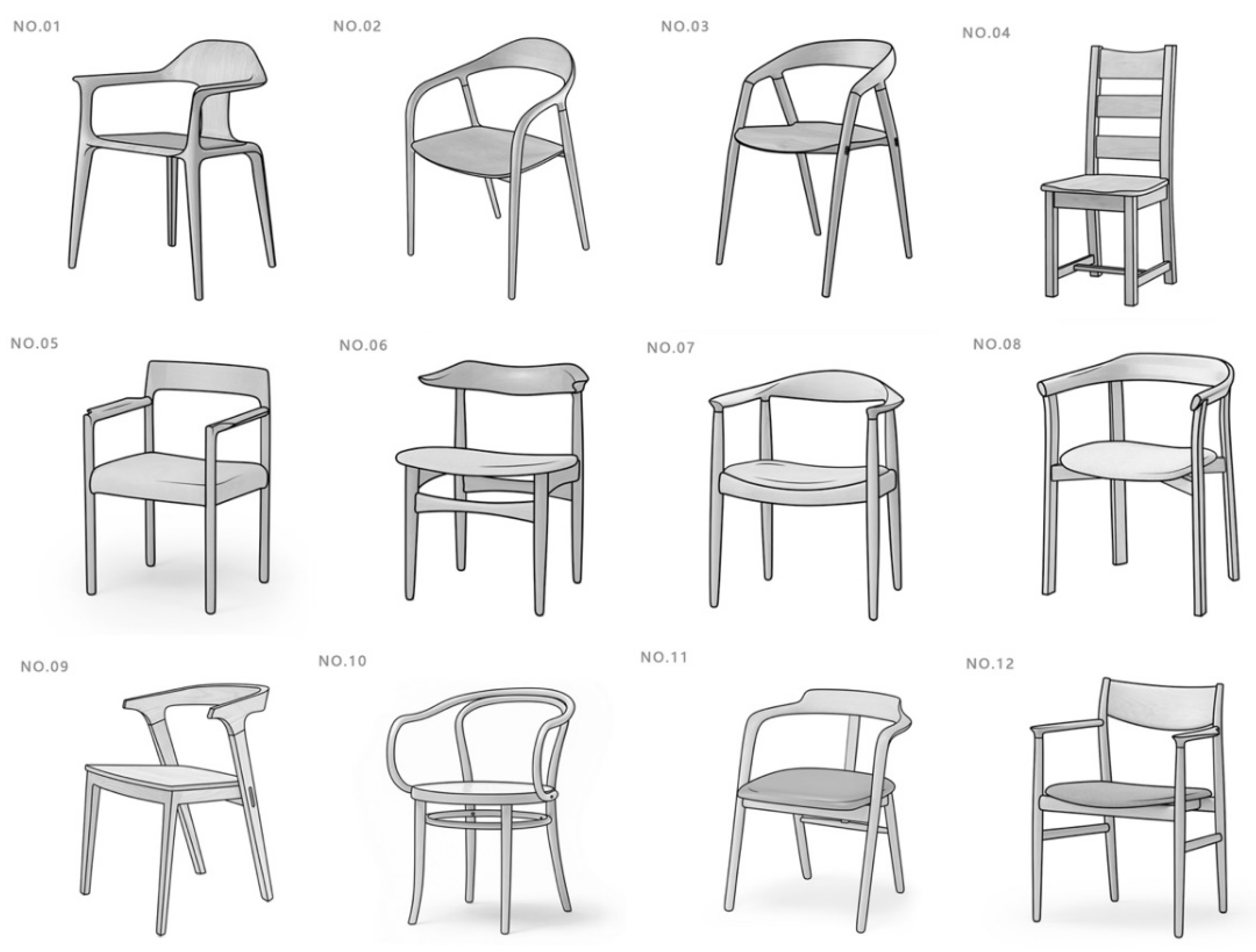

| Stress | Matching Degree |
|---|---|
| 0.2 | Poor |
| 0.1 | Fair |
| 0.05 | Good |
| 0.25 | Excellent |
| 0 | Perfect |
| Linguistic Variables |
|---|
| Very Low (VL) |
| Low (L) |
| Medium Low (L) |
| Medium (M) |
| Medium high (MH) |
| High (H) |
| Very High (VH) |
| Dimensions | Stress |
|---|---|
| 2 | 0.15254 |
| 3 | 0.11235 |
| 4 | 0.08952 |
| Sample | Category | Distance | Sample | Category | Distance |
|---|---|---|---|---|---|
| S7 | 1 | 4.84651 | S26 | 7 | 2.90934 |
| S118 | 2 | 3.10012 | S36 | 8 | 3.51596 |
| S102 | 3 | 4.92846 | S43 | 9 | 2.47886 |
| S50 | 4 | 2.28655 | S12 | 10 | 2.76357 |
| S88 | 5 | 4.84236 | S76 | 11 | 4.80691 |
| S23 | 6 | 2.64236 | S63 | 12 | 4.18767 |
| Quality | Artisanal | Detailed | Harmonious | Stylish |
| Crafted | Elegant | High-quality | Coordinated | Aligned |
| Simple | Durable | Overall | Eco-friendly | Lightweight |
| Practical | Safe | Sturdy | Novel | Balanced |
| Natural | Stable | Modern | Precise | Concordant |
| Refined | Superior | Demure | Orderly | Austere |
| Smooth | Unique | Traditional | Quaint | Delicate |
| Exquisite | Innovative | Serviceable | Plain | Comfortable |
| Adjectives | Initial | Extraction | Adjectives | Initial | Extraction |
|---|---|---|---|---|---|
| Harmonious | 1 | 0.782 | Safe | 1 | 0.761 |
| Coordinated | 1 | 0.765 | Serviceable | 1 | 0.671 |
| Orderly | 1 | 0.719 | Practical | 1 | 0.627 |
| Aligned | 1 | 0.703 | Crafted | 1 | 0.745 |
| Balanced | 1 | 0.686 | Quality | 1 | 0.718 |
| Concordant | 1 | 0.638 | Detailed | 1 | 0.717 |
| Unique | 1 | 0.774 | Exquisite | 1 | 0.601 |
| Novel | 1 | 0.768 | Traditional | 1 | 0.786 |
| Innovative | 1 | 0.745 | Plain | 1 | 0.637 |
| Stylish | 1 | 0.694 | Simple | 1 | 0.742 |
| Modern | 1 | 0.656 | Elegant | 1 | 0.718 |
| Stable | 1 | 0.805 |
| Adjectives | Component | ||||
|---|---|---|---|---|---|
| 1 | 2 | 3 | 4 | 5 | |
| Aligned Balanced Concordant Coordinated Orderly Unique Novel Innovative Modern Practical Simple Quality Crafted Detailed Traditional Plain |
0.838 0.812 0.807 0.750 0.727 |
0.867 0.806 0.800 0.669 |
0.741 0.608 |
0.786 0.751 0.632 |
0.860 0.638 |
| Factor | Adjective Groups | Factor Naming | Code |
|---|---|---|---|
| 1 | Aligned, Balanced, Concordant, Coordinated, Orderly | Balanced and Coordinated | B&C |
| 2 | Unique, Novel, Innovative, Modern, Elegant | Unique and Novel | U&N |
| 3 | Practical, Simple, Serviceable | Practical and Simple | P&S |
| 4 | Quality, Crafted, Detailed | Quality and Detailed | Q&D |
| 5 | Traditional, Plain | Traditional and Plain | T&P |
| Balanced and Coordinated |
Unique and Novel |
Practical and Simple |
Quality and Detailed |
Traditional and Plain |
|---|---|---|---|---|
| S7 (5.4,7.1,8.5) | S9 (5.2,7.1,8.5) | S1 (5.3,7.1,8.6) | S7 (5.1,6.9,8.4) | S7 (4.4,6.2,7.9) |
| S1 (4.7,6.6,8.2) | S10 (5.0,6.8,8.4) | S2 (5.0,6.8,8.4) | S1 (4.8,6.5,8.1) | S2 (4.1,5.9,7.6) |
| S11 (4.5,6.4,8.1) | S6 (4.4,6.2,7.9) | S7 (4.9,6.7,8.3) | S9 (4.3,6.1,7.8) | S1 (4.0,5.8,7.5) |
| S12 (4.5,6.4,8.1) | S7 (4.4,6.2,7.9) | S9 (4.6,6.5,8.1) | S11 (4.1,6.0,7.8) | S12 (3.9,5.8,7.6) |
| S9 (4.5,6.3,8.0) | S8 (4.3,6.2,7.9) | S8 (4.3,6.2,7.8) | S6 (4.1,5.9,7.6) | S11 (3.9,5.7,7.6) |
| S2 (4.4,6.3,8.0) | S1 (4.0,5.8,7.5) | S3 (4.2,6.1,7.8) | S8 (3.9,5.8,7.5) | S4 (4.0,5.7,7.2) |
| S8 (4.4,6.2,7.8) | S11 (3.7,5.5,7.3) | S11 (4.1,6.0,7.7) | S10 (3.9,5.6,7.3) | S3 (3.7,5.6,7.3) |
| S5 (4.4,6.2,7.7) | S3 (3.4,5.2,6.9) | S5 (3.9,5.8,7.5) | S3 (3.8,5.6,7.4) | S5 (3.9,5.6,7.4) |
| S10 (4.0,5.7,7.4) | S12 (3.4,5.2,6.9) | S6 (3.9,5.8,7.5) | S12 (3.8,5.6,7.4) | S9 (3.7,5.5,7.3) |
| S6 (3.9,5.7,7.4) | S2 (2.9,4.6,6.5) | S12 (3.8,5.7,7.5) | S2 (3.7,5.6,7.3) | S8 (3.6,5.5,7.2) |
| S3 (3.8,5.6,7.4) | S5 (2.8,4.4,6.2) | S10 (3.5,5.2,7.0) | S5 (3.3,5.1,6.8) | S6 (3.6,5.4,7.2) |
| S4 (3.8,5.5,7.1) | S4 (1.5,2.8,4.4) | S4 (3.3,5.0,6.7) | S4 (1.9,3.5,5.3) | S10 (3.4,5.1,6.8) |
| Samples | Balanced and Coordinated |
Unique and Novel |
Practical and Simple |
Quality and Detailed |
Traditional and Plain |
|---|---|---|---|---|---|
| S1 | 0.5868 | 0.4754 | 0.6621 | 0.5787 | 0.4754 |
| S2 | 0.5454 | 0.3097 | 0.6195 | 0.4439 | 0.49 |
| S3 | 0.4493 | 0.3878 | 0.5164 | 0.4493 | 0.4439 |
| S4 | 0.4305 | 0.0278 | 0.3603 | 0.1451 | 0.457 |
| S5 | 0.5287 | 0.2775 | 0.4729 | 0.3732 | 0.4516 |
| S6 | 0.4608 | 0.5338 | 0.4729 | 0.49 | 0.4203 |
| S7 | 0.6644 | 0.5232 | 0.6048 | 0.6324 | 0.5338 |
| S8 | 0.5313 | 0.5309 | 0.5284 | 0.4729 | 0.4294 |
| S9 | 0.5484 | 0.6566 | 0.5722 | 0.5192 | 0.4348 |
| S10 | 0.4724 | 0.6195 | 0.3932 | 0.4485 | 0.375 |
| S11 | 0.5599 | 0.4348 | 0.5019 | 0.5046 | 0.4667 |
| S12 | 0.5599 | 0.3878 | 0.4614 | 0.4493 | 0.4758 |
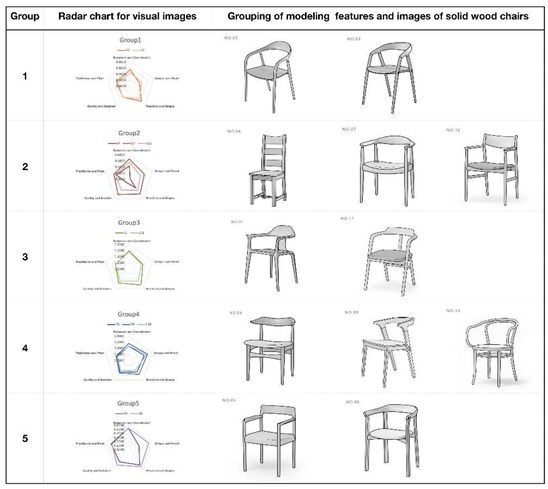 |
Disclaimer/Publisher’s Note: The statements, opinions and data contained in all publications are solely those of the individual author(s) and contributor(s) and not of MDPI and/or the editor(s). MDPI and/or the editor(s) disclaim responsibility for any injury to people or property resulting from any ideas, methods, instructions or products referred to in the content. |
© 2024 by the authors. Licensee MDPI, Basel, Switzerland. This article is an open access article distributed under the terms and conditions of the Creative Commons Attribution (CC BY) license (https://creativecommons.org/licenses/by/4.0/).





